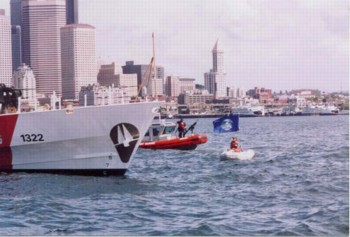|
||||
|
|
|
|||
| Home | Subscribe | Back Issues | The Organization | Volunteer | ||||
|
||||
Welcome Seafair?by Glen MilnerEach July and August, Seattle becomes home to one of the largest military recruitment and military public affairs events in the United States. Fighter planes buzz the skyline, U.S. Navy and Coast Guard vessels commandeer Elliott Bay, and military commanders are given VIP treatment in our city. Supposedly a mix of maritime entertainment and cultural values, Seafair has become its own purpose and has taken on a life of its own. At the heart of the matter are annual agreements between Seafair and Navy Region Northwest. In a letter dated April 7, 2004 to Rear Admiral Len Hering, Seafair President Beth Wojick stated "Throughout our history, Seafair has continued to serve as an important catalyst for public outreach and community involvement for our military neighbors." Seafair specifically requested the following from Navy Region Northwest: the U.S. Navy Band at the Torchlight Parade; opportunities to host VIPs on visiting ships and other Navy cruises; and the U.S. Navy Blue Angels, including staging platforms and a Navy tug to deliver Navy barges for the hydroplane races. The April 7 letter continued, "In exchange for the above, Seafair will provide the following opportunities (for the Navy)": U.S. Navy aircraft flying shows; U.S. Navy helicopter demonstration; the opportunity for the Commanding Officer to participate as VIP in the Torchlight Parade and Recruiting Display Space at Genesee Park. The letter to the Navy also stated, "As you know, Seafair is a non-profit organization and we could not afford to pay for the in-kind services that you and your team provide." In 1998 and in 2000, Seafair gave us the horror of a Trident submarine, complete with up to 192 nuclear warheads, in downtown Seattle. In the past, Navy Recruiting has been the prime sponsor of the Milk Carton Derby at Green Lake. The 2005 Seafair website lists the festival as our "home town jewel." The latest 990 IRS financial statement for Seafair, for 2003, stated the organization took in $1,912,280 in revenue and spent a total of $2,741,156. While creating an $828,000 deficit for the year, the Seafair President was paid $157,441 in salary with an additional $14,000 in employee expenses and contributions. According to the 990 IRS statement, the non-profit organization paid 9% of all income for the year to one employee.
We all pay for Seafair in many ways. We pay our Seattle police for traffic and crowd control. Seattle Public Schools recently proposed the closure of ten community schools, and at the same time we pay for the Blue Angels fighter jets and the billions of dollars of military hardware that come into our city. In recent years we have paid for Seafair with our civil liberties. For three years, a group of peace activists have formed a water-borne protest to meet the U.S. Navy fleet arrival in Elliott Bay in August. Members each year have contacted the Navy of their intention to protest the fleet arrival and their intention to follow applicable maritime laws. In 2000, members were visited in a meeting by a Port of Seattle police officer posing as a Catholic Worker/Teamster. The peace boat that met the Trident submarine that year was ordered out of Elliott Bay by the Coast Guard. In 2004, demonstrators hoped to publicize that all five Navy warships at Seafair had gun systems used to routinely fire radioactive or depleted uranium munitions during calibration off the Washington Coast. The Navy was again notified that the Peace Fleet would be present and would be obeying all laws. Two days before the fleet arrival on August 5, 2004, Jim Diamond of the US Coast Guard Field Intelligence Support Team, a vanguard intelligence unit of the Department of Homeland Security, called one of the organizers. On the morning of August 5, Diamond called again and was told the exact number of vessels in the Peace Fleet and their descriptions. Both times the Coast Guard warned that demonstrators not go out on the water. On August 5, the Coast Guard boarded two of the three Peace Fleet vessels and terminated the voyage of an 11-foot inflatable, owned by the Ground Zero Center for Nonviolent Action. The two in this boat were later held at armed guard by the Coast Guard in downtown Seattle. Nine months later, in April 2005, the skipper of the Ground Zero inflatable--myself--received a $10,000 civil penalty from the Coast Guard for being too close to a US Navy vessel. In the case of a Coast Guard civil penalty, however, there is no due process. Only one Coast Guard Hearing Officer decides innocence or guilt. The case is pending. Seattle could have a real maritime festival with sailboat races in Elliott Bay and perhaps featured events honoring our Native American and Northwest fishing traditions. As long as we allow Seafair and the US Navy to use the event as a public-relations tool for the military, we will get more of the same. Glen Milner lives in Seattle and is a member of the Ground Zero Center for Nonviolent Action. Please see www.gzcenter.org . |
|

